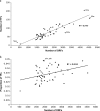Identification and genomic analysis of transcription factors in archaeal genomes exemplifies their functional architecture and evolutionary origin
- PMID: 20123795
- PMCID: PMC2872624
- DOI: 10.1093/molbev/msq033
Identification and genomic analysis of transcription factors in archaeal genomes exemplifies their functional architecture and evolutionary origin
Abstract
Archaea, which represent a large fraction of the phylogenetic diversity of organisms, are prokaryotes with eukaryote-like basal transcriptional machinery. This organization makes the study of their DNA-binding transcription factors (TFs) and their transcriptional regulatory networks particularly interesting. In addition, there are limited experimental data regarding their TFs. In this work, 3,918 TFs were identified and exhaustively analyzed in 52 archaeal genomes. TFs represented less than 5% of the gene products in all the studied species comparable with the number of TFs identified in parasites or intracellular pathogenic bacteria, suggesting a deficit in this class of proteins. A total of 75 families were identified, of which HTH_3, AsnC, TrmB, and ArsR families were universally and abundantly identified in all the archaeal genomes. We found that archaeal TFs are significantly small compared with other protein-coding genes in archaea as well as bacterial TFs, suggesting that a large fraction of these small-sized TFs could supply the probable deficit of TFs in archaea, by possibly forming different combinations of monomers similar to that observed in eukaryotic transcriptional machinery. Our results show that although the DNA-binding domains of archaeal TFs are similar to bacteria, there is an underrepresentation of ligand-binding domains in smaller TFs, which suggests that protein-protein interactions may act as mediators of regulatory feedback, indicating a chimera of bacterial and eukaryotic TFs' functionality. The analysis presented here contributes to the understanding of the details of transcriptional apparatus in archaea and provides a framework for the analysis of regulatory networks in these organisms.
Figures






Similar articles
-
New insights on gene regulation in archaea.Comput Biol Chem. 2011 Dec 14;35(6):341-6. doi: 10.1016/j.compbiolchem.2011.10.006. Epub 2011 Oct 17. Comput Biol Chem. 2011. PMID: 22099630 Review.
-
Comparative genomics of DNA-binding transcription factors in archaeal and bacterial organisms.PLoS One. 2021 Jul 2;16(7):e0254025. doi: 10.1371/journal.pone.0254025. eCollection 2021. PLoS One. 2021. PMID: 34214112 Free PMC article.
-
Deciphering the functional diversity of DNA-binding transcription factors in Bacteria and Archaea organisms.PLoS One. 2020 Aug 21;15(8):e0237135. doi: 10.1371/journal.pone.0237135. eCollection 2020. PLoS One. 2020. PMID: 32822422 Free PMC article.
-
Evaluation of the Abundance of DNA-Binding Transcription Factors in Prokaryotes.Genes (Basel). 2020 Jan 3;11(1):52. doi: 10.3390/genes11010052. Genes (Basel). 2020. PMID: 31947717 Free PMC article.
-
The repertoire of DNA-binding transcription factors in prokaryotes: functional and evolutionary lessons.Sci Prog. 2012;95(Pt 3):315-29. doi: 10.3184/003685012X13420097673409. Sci Prog. 2012. PMID: 23094327 Free PMC article. Review.
Cited by
-
REGULATOR: a database of metazoan transcription factors and maternal factors for developmental studies.BMC Bioinformatics. 2015 Apr 10;16:114. doi: 10.1186/s12859-015-0552-x. BMC Bioinformatics. 2015. PMID: 25880930 Free PMC article.
-
TbsP and TrmB jointly regulate gapII to influence cell development phenotypes in the archaeon Haloferax volcanii.Mol Microbiol. 2024 Apr;121(4):742-766. doi: 10.1111/mmi.15225. Epub 2024 Jan 11. Mol Microbiol. 2024. PMID: 38204420 Free PMC article.
-
Old cogs, new tricks: the evolution of gene expression in a chromatin context.Nat Rev Genet. 2019 May;20(5):283-297. doi: 10.1038/s41576-019-0105-7. Nat Rev Genet. 2019. PMID: 30886348 Review.
-
Systematic Discovery of Archaeal Transcription Factor Functions in Regulatory Networks through Quantitative Phenotyping Analysis.mSystems. 2017 Sep 19;2(5):e00032-17. doi: 10.1128/mSystems.00032-17. eCollection 2017 Sep-Oct. mSystems. 2017. PMID: 28951888 Free PMC article.
-
Histone and TK0471/TrmBL2 form a novel heterogeneous genome architecture in the hyperthermophilic archaeon Thermococcus kodakarensis.Mol Biol Cell. 2011 Feb 1;22(3):386-98. doi: 10.1091/mbc.E10-08-0668. Mol Biol Cell. 2011. PMID: 21148291 Free PMC article.
References
-
- Aravind L, Anantharaman V, Balaji S, Babu MM, Iyer LM. The many faces of the helix-turn-helix domain: transcription regulation and beyond. FEMS Microbiol Rev. 2005;29:231–262. - PubMed
-
- Auguet JC, Barberan A, Casamayor EO. Global ecological patterns in uncultured archaea. ISME J. 2009;4:182–190. - PubMed
-
- Babu MM, Luscombe NM, Aravind L, Gerstein M, Teichmann SA. Structure and evolution of transcriptional regulatory networks. Curr Opin Struct Biol. 2004;14:283–291. - PubMed
Publication types
MeSH terms
Substances
LinkOut - more resources
Full Text Sources
Molecular Biology Databases

